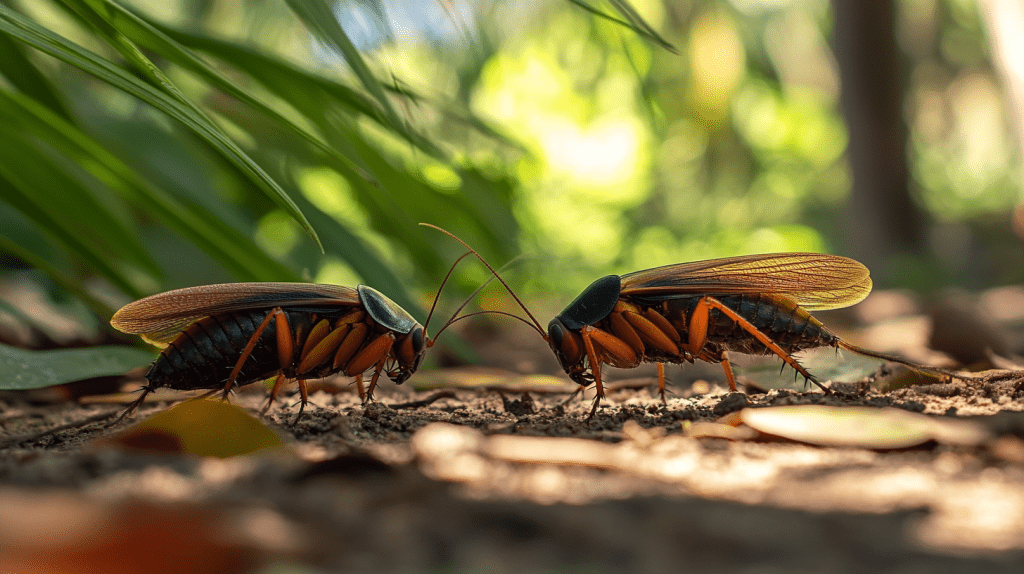
Table of Contents
If you live in Palmetto, FL, you’re likely no stranger to the challenge of dealing with cockroaches. Florida’s warm, humid climate creates the perfect environment for these pests to thrive year-round. Whether it’s the American cockroach, also known as the palmetto bug, or the fast-breeding German cockroach, these insects can quickly invade your home and become a serious problem. To successfully get rid of roaches, understanding their behavior and survival tactics is key.
Roaches are incredibly resilient—some species can live for a month without food or even survive without their head for several weeks! They are nocturnal creatures, which means if you spot them during the day, it could indicate a large infestation. Roaches are also fast movers, capable of running up to 3 miles per hour, making them hard to catch or eliminate with quick fixes.
One of the most concerning facts is that cockroaches don’t just infest homes; they can also trigger allergic reactions and asthma in sensitive individuals due to their droppings, saliva, and shed skins. Roaches are attracted to food sources, which means maintaining cleanliness in your home is crucial. Even small crumbs or grease can draw them in, and they can feed on just about anything—including paper and cardboard.
In this post, we’ll explore the best strategies to get rid of roaches in Palmetto, FL, from natural methods to professional pest control solutions. Whether you’re dealing with a small infestation or a more severe problem, we’ll provide actionable tips to help keep your home roach-free and protect your family from these unwanted invaders.
Key Takeaways
- Identification is Crucial: Knowing the type of roach (German, American, etc.) infesting your home helps you select the most effective treatment method.
- Thorough Inspection: Use flashlights and glue traps to locate roach hiding spots, focusing on kitchens and bathrooms for German roaches and basements or external entry points for American roaches.
- Prioritize Sanitation: Cleanliness significantly reduces roach infestations. Immediate cleanup of food spills, secure food storage, and fixing leaks are essential preventive measures.
- Targeted Treatment Plans: Use baits and insect growth regulators (IGRs) for German roaches and residual insecticides and granular baits for American roaches. Sticky traps and natural remedies like diatomaceous earth can also be effective.
- Professional Help: If DIY methods aren’t working, consult a professional roach exterminator for comprehensive solutions.
- Preventive Measures: Regular inspections, sealing cracks, and exterior perimeter treatments help maintain a roach-free home environment.
What Are Cockroaches?
Cockroaches are insects belonging to the order Blattodea. These resilient creatures vary in size from 0.5 to 2 inches long and have a flat, oval-shaped body that helps them hide in cracks and crevices. Cockroaches are typically brown or black, and most species are nocturnal, preferring warm, humid, and dark environments like kitchens and basements. Though they are important decomposers in nature, several species are pests in human dwellings, contaminating food and spreading pathogens.
What Kind of Cockroaches Are In Palmetto, FL?
Palmetto, FL, is home to a variety of cockroach species, thriving in its warm and humid climate. The American cockroach, also known as the palmetto bug, is one of the most common in the area. Known for its large size—up to 2 inches long—and reddish-brown color, it’s a frequent visitor in homes, especially in moist areas like sewers or basements. German cockroaches, smaller but more prolific, are another significant pest, often found in kitchens and bathrooms, where they breed quickly. A single female can lay up to 40 eggs per case, making infestations grow rapidly.
You might also encounter the Florida woods cockroach, a slower-moving species often found outdoors. Meanwhile, Asian cockroaches—which can fly—can be confused with German cockroaches but are typically found outside in leaf litter. Each species presents its own challenges, but knowing which kind of roach you’re dealing with is the first step to getting rid of them effectively.
Understanding the specific types of cockroaches in your home will help you choose the best treatment plan to eliminate these resilient pests. Keep reading to learn more about how to identify and combat these roaches in Palmetto, FL.
Cockroaches in Palmetto, Florida
1. American Cockroach (Palmetto Bug)
The largest common species, growing up to 2 inches long. Reddish-brown with a yellow shield on their head. They can fly short distances.
2. Florida Woods Cockroach
Large, up to 1.5 inches long and 1 inch wide. Dark reddish-brown to black. Primarily an outdoor species, but occasionally enters homes.
3. Smokybrown Cockroach
About 1 inch long, with a mahogany brown color that is darker than American roaches. Strong flyers, often found around outdoor lights.
4. German Cockroach
The smallest common species, about 1/2 inch long. Light brown with two dark stripes behind the head. Primarily an indoor species and one of the most problematic for homeowners.
5. Asian Cockroach
Similar in appearance to German cockroaches. Strong flyers and attracted to lights. Primarily an outdoor species but may enter homes.
6. Brown-banded Cockroach
About 1/2 inch long. Dark brown with two light brown bands across the body. Prefers drier environments, often found in higher areas of homes.
7. Oriental Cockroach
A large species often found in damp areas. Attracted to moisture and commonly seen in bathrooms and crawl spaces.
These species vary in habits, habitats, and likelihood of becoming indoor pests. While some, like the Florida Woods Cockroach, are primarily outdoor species, others like the German Cockroach are more likely to infest homes. Palmetto, Florida’s warm, humid climate provides a perfect environment for various cockroach species to thrive.
Roach Identification by Adult Size and Habitat
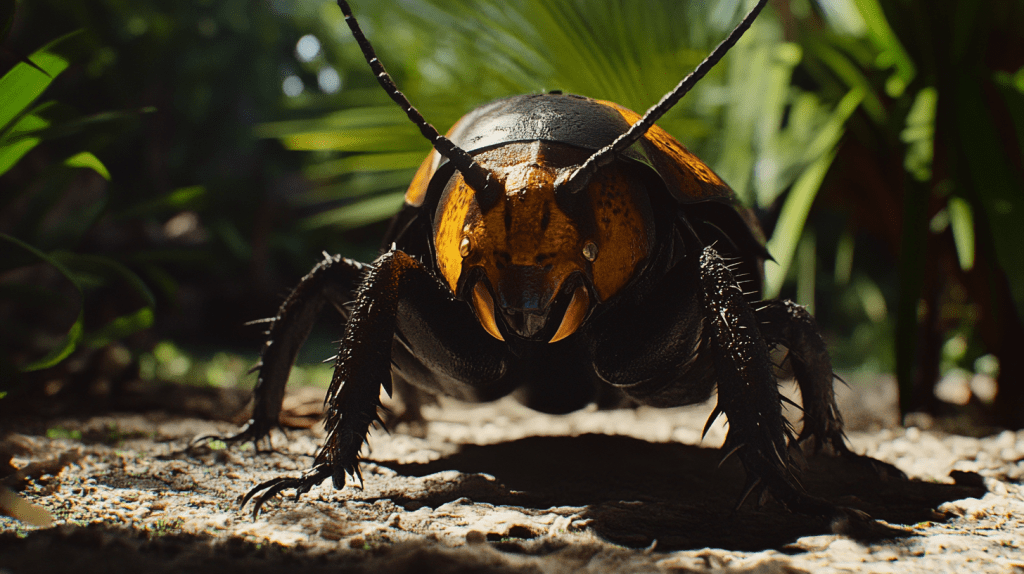
Understanding the different roach species in your Palmetto, FL home helps target your control efforts effectively. Let’s break it down by size and habitat to make your roach elimination strategy as as possible.
Identifying American Cockroaches (Also Known as Palmetto Bugs)
American cockroaches, often called Palmetto Bugs, are the largest and most recognizable roach species. These pests can grow up to 2 inches long, making them much larger than other common cockroach species. Their reddish-brown bodies are highlighted by a distinctive yellow, shield-like marking behind their head, known as the pronotum. While they are primarily nocturnal, their speed and ability to glide short distances make them quick to escape when threatened. With their large compound eyes featuring over 3,500 lenses, they are highly adapted to navigating dark environments.
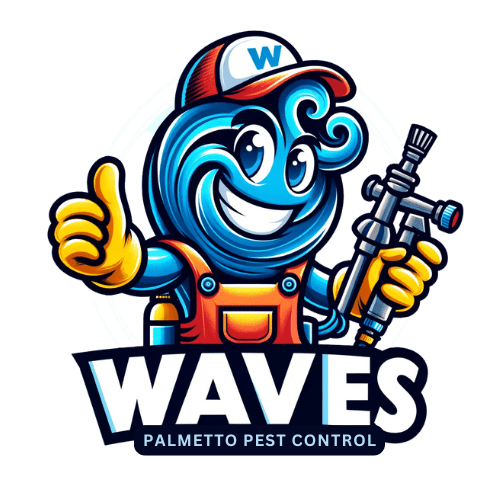
Effective Roach Control in Palmetto!
Tired of sharing your home with pests? Contact Palmetto Pest Control at (941) 294-3355 for prompt, professional service. Proudly serving Palmetto, FL, we provide effective pest solutions that keep your home safe and pest-free all year long.
Get StartedAmerican cockroaches are equipped with wings and can fly or glide short distances, which adds to their ability to surprise homeowners. They are notorious for seeking out warm, moist environments, such as basements, crawl spaces, and sewers, but can also survive in drier areas as long as they have access to water. Interestingly, these cockroaches can survive up to 600 days, and their life cycle includes 13 molts before reaching adulthood, making them long-lasting and persistent pests.
Another notable characteristic of American cockroaches is their diet. They are omnivorous, feeding on a wide range of organic materials, but they particularly enjoy fermenting foods, starches, and sugars. Their size and reddish-brown color set them apart from smaller species like German cockroaches, which are lighter brown and far less capable of flying.
Despite being called Palmetto Bugs, these roaches are the same American cockroaches known for thriving in the warm, humid environments of Florida. Their adaptability, speed, and ability to survive in various conditions make them a challenging pest to eliminate, especially in areas like Palmetto where the climate is perfect for their year-round activity.
American Cockroach Identification (Palmetto Bug)

Physical Characteristics
- Size: Largest common cockroach species, growing up to 1.5-2 inches (29-53 mm) long.
- Color: Reddish-brown to dark brown.
- Distinctive marking: Yellow shield-like marking behind the head.
- Body shape: Oval-shaped body with a shield-like pronotum.
- Antennae: Long, segmented antennae.
Key Identifying Features
- Both males and females have wings and can fly short distances or glide.
- Large compound eyes with over 3500 individual lenses.
- Yellowish margin on the pronotum (area behind the head).
Behavior
- Primarily nocturnal and fast runners.
- Can squeeze through small cracks and crevices.
- Prefer moist, warm environments but can survive in drier areas with access to water.
Habitat
- Common in basements, crawl spaces, sewers, and areas with organic debris.
- In residential areas, often found in basements, moving outdoors in warm weather.
- Attracted to moist areas around 29°C (84°F).
Life Cycle
- Three stages: egg, nymph, and adult.
- Females produce egg cases (oothecae) containing multiple eggs.
- Nymphs undergo 13 molts before reaching adulthood.
- Total life cycle can last up to 600 days.
Diet
- Omnivorous, feeding on a wide variety of organic matter.
- Particularly fond of fermenting foods, starches, and sugars.
Key Identification Points
- Larger size compared to German cockroaches (which are about 1/2 inch long).
- Reddish-brown color versus the lighter brown of German cockroaches.
- Ability to glide short distances, unlike some other cockroach species.
While called “Palmetto Bugs” in some regions, especially in the southern United States, this is just another name for the American Cockroach.
Identifying Florida Woods Cockroaches (Eurycotis floridana)
The Florida Woods Cockroach, also known as Eurycotis floridana, is a large cockroach species native to the southeastern United States, particularly Florida. These cockroaches are easily recognized by their dark reddish-brown to black coloring and their thick, oval-shaped body, which measures around 1.2 to 1.6 inches long. Unlike other cockroach species, they have very short wings, called tegmina, that barely extend past the mesonotum, giving them the appearance of being almost wingless. Despite having wings, Florida Woods Cockroaches do not fly and are also much slower-moving compared to other species.
One of the most distinctive features of the Florida Woods Cockroach is its defensive mechanism. When threatened, it can spray a foul-smelling liquid up to 1 meter, which serves as a deterrent to predators. These cockroaches are nocturnal and prefer to be active at night, foraging in damp, humid environments such as wooded areas, leaf litter, or under rotting logs. While they primarily live outdoors, they can occasionally enter homes, particularly in damp areas like bathrooms.
Another key identifier for these cockroaches is their egg cases (oothecae), which are 14-16 mm long and contain around 21-23 eggs. Their dark color, larger size, and thicker body differentiate them from common household roaches like the American or German cockroach, and their inability to fly and slow movement further set them apart. While they are sometimes called Palmetto Bugs, it’s important to note that they are a different species from the American Cockroach, which shares the same nickname in certain regions.
Despite their intimidating size and unique defense, Florida Woods Cockroaches are mostly outdoor dwellers and don’t pose the same level of infestation risk as other cockroach species. However, their presence can still be alarming, especially if they wander indoors.
Florida Woods Cockroach Identification
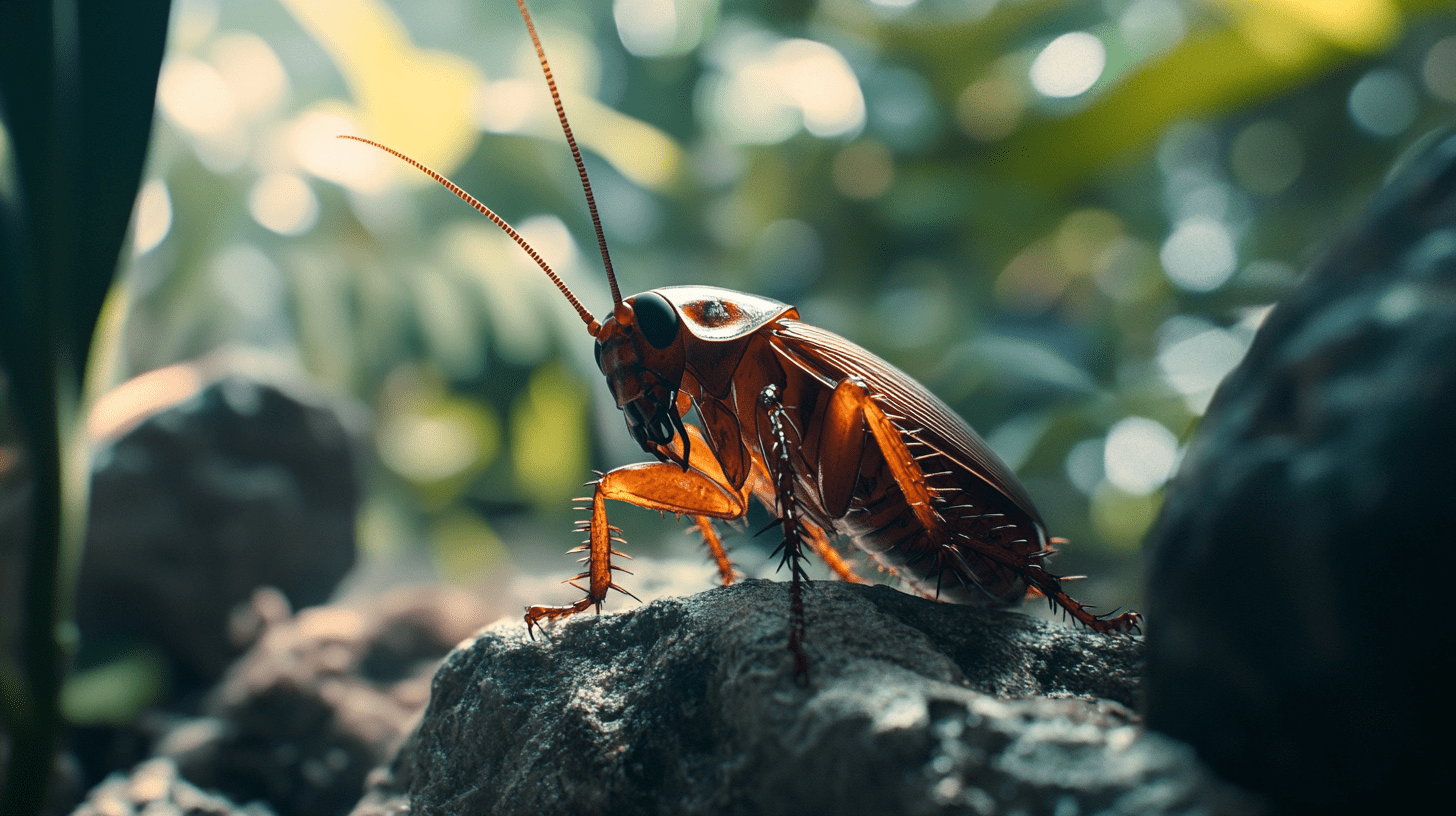
Physical Characteristics
- Size: Large, typically 1.2 to 1.6 inches (30-40 mm) long and about 1 inch wide.
- Color: Dark reddish-brown to black; may appear lighter after molting.
- Body shape: Thick, oval-shaped body.
Distinctive Features
- Wings: Very short wings (tegmina) that only extend just past the mesonotum; no hind wings.
- Appearance: Often described as “wingless” due to the small size of their wings.
- Movement: Slow-moving compared to other cockroach species.
Behavior
- Defensive mechanism: Can spray a foul-smelling liquid up to 1 meter when alarmed.
- Nocturnal: Active at night, foraging and exploring.
- Habitat preference: Prefers damp, humid environments.
Other Identifying Factors
- Often confused with female Oriental cockroaches due to similar appearance.
- Produces egg cases (oothecae) that are 14-16 mm long and contain 21-23 eggs.
- Does not fly, despite having small wings.
Habitat
- Primarily found outdoors in wooded areas, gardens, leaf litter, and under rotting logs.
- May occasionally enter homes, especially in damp areas like bathrooms.
- Native to southeastern United States, particularly Florida.
How to Distinguish from Other Cockroaches
- Larger size compared to many common household roaches.
- Darker color and thicker body than American or German cockroaches.
- Inability to fly and slow movement.
- Distinctive foul-smelling spray when threatened.
While called “Palmetto Bugs” in some regions, this species is distinct from the American Cockroach, which is also sometimes referred to by that name.
Identifying and Controlling Smokybrown Cockroaches
Smokybrown cockroaches are a common pest in Florida and other warm, humid environments. These cockroaches are easy to identify due to their dark mahogany brown to almost black color and their size, measuring between 1.25 to 1.5 inches long. Both males and females have fully developed wings that extend beyond their bodies, making them strong fliers, often attracted to lights at night. Their long antennae, often as long or longer than their body, help them navigate through their environment. The nymphs are notable for their dark brown color with white bands on their back and antennae tips.
Smokybrown cockroaches thrive in warm, humid environments and are often found outdoors in wooded areas, leaf litter, and dense vegetation. However, they frequently enter homes through small openings, where they tend to inhabit attics and crawl spaces. These cockroaches require regular access to moisture, which is why they are often found near leaky pipes, drains, or other water sources inside homes.
The life cycle of the Smokybrown cockroach begins with females producing 17-26 eggs per ootheca (egg case). Nymphs take between 6 to 12 months to develop into adults, and the adult cockroaches can live for another 6 to 12 months.
Smokybrown Cockroach Identification and Control
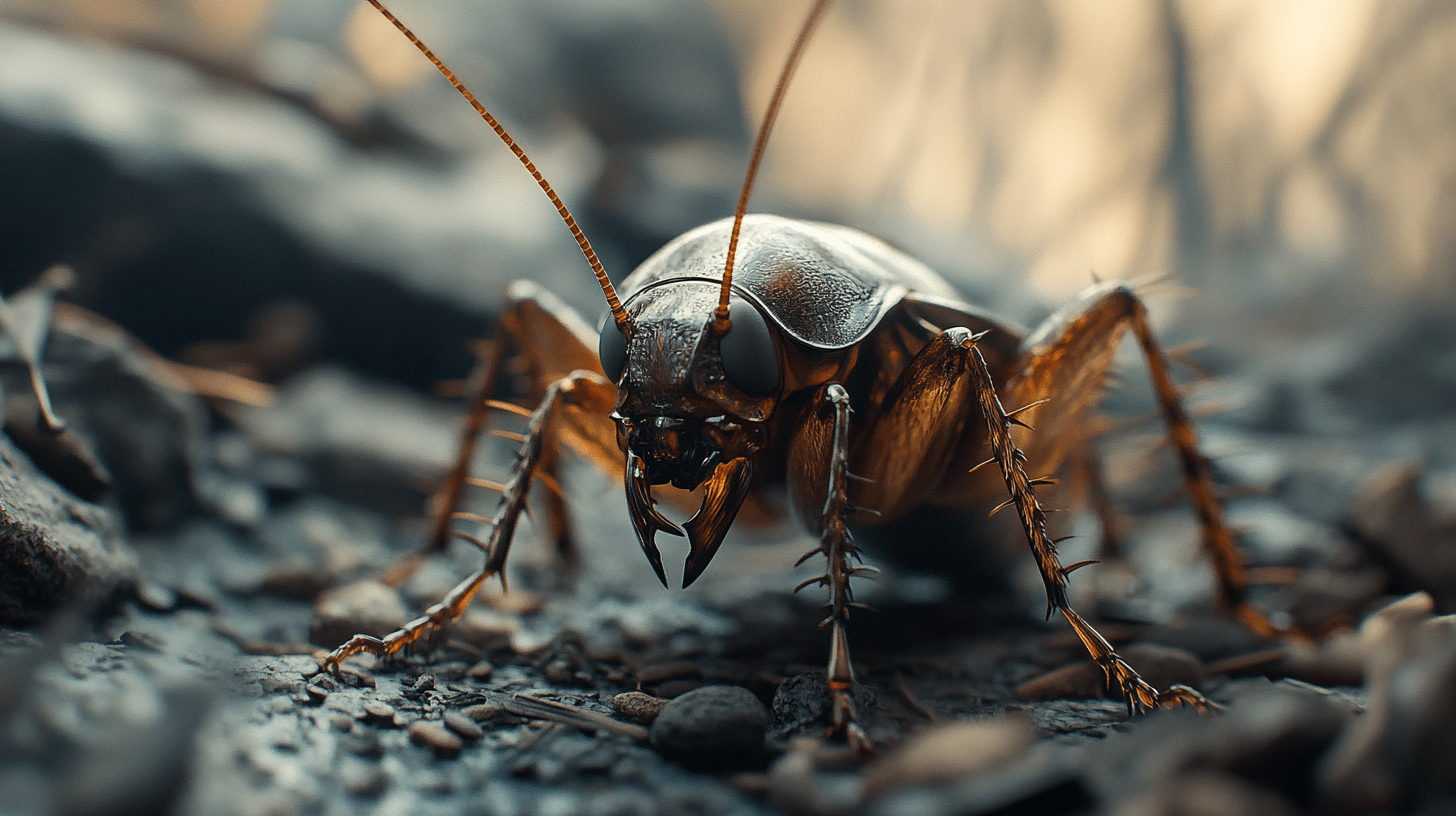
Identification
- Size: 1.25 to 1.5 inches long.
- Color: Dark mahogany brown to almost black.
- Wings: Fully developed, extending beyond the body in both males and females.
- Antennae: About the same length as or longer than the body.
- Nymphs: Dark brown with white bands on back and antennae tips.
Behavior and Habitat
- Strong fliers, attracted to lights at night.
- Warm, humid environments: Often found outdoors in wooded areas, leaf litter, and vegetation.
- Indoor habitats: Can enter homes through small openings, often inhabiting attics and crawl spaces.
- Need for moisture: Often found near water sources like leaky pipes and drains.
Life Cycle
- Eggs: Females produce 17-26 eggs per ootheca (egg case).
- Nymph development: Nymphs take 6-12 months to develop into adults.
- Lifespan: Adults live for 6-12 months.
Control Methods
- Reduce moisture: Ensure proper ventilation in attics and crawl spaces. Fix leaky pipes and drains.
- Seal entry points: Install tight-fitting screens on foundation and attic vents. Seal cracks and holes on the exterior of the home.
- Eliminate food sources: Don’t leave pet food out overnight. Properly store and dispose of garbage.
- Remove harborage areas: Keep firewood away from the house and off the ground. Eliminate piles of lumber and debris.
- Use baits and insecticides: Apply cockroach baits in infested areas. Consider professional pest control services for severe infestations.
- Regular cleaning and monitoring: Vacuum regularly, especially in potential hiding spots. Monitor for signs of infestation (droppings, egg cases, live or dead roaches).
Persistent efforts and a combination of methods are often necessary for effective control of Smokybrown Cockroaches.
4 Key Steps to Get Rid of Roaches
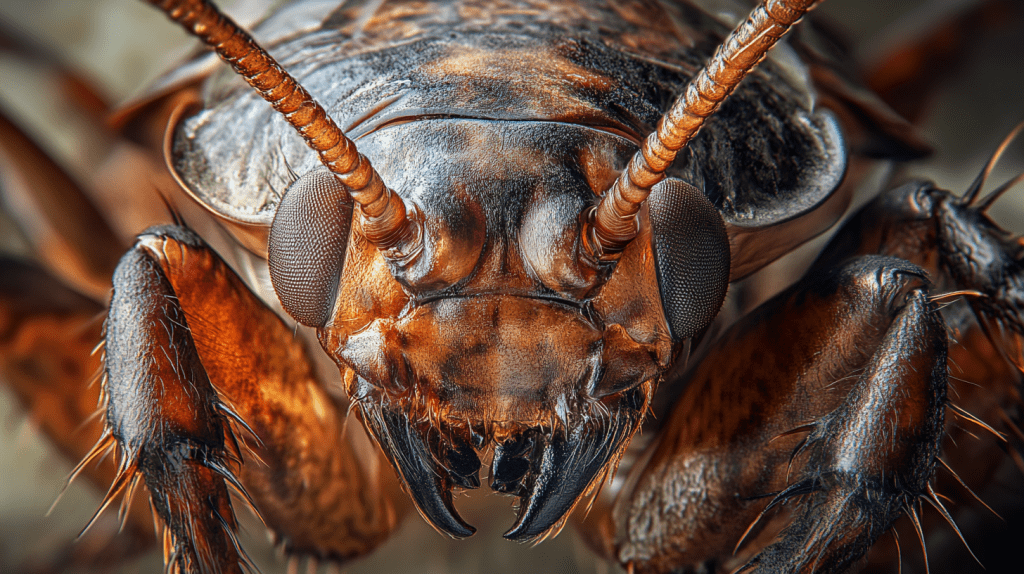
Roaches—those unwelcome housemates—can make any home feel uncomfortable. But eliminating them isn’t as complicated as it seems. With targeted strategies, you can reclaim your space. Let’s jump into the four key steps to get rid of roaches.
- Roach Identification: Identify the type of roach infesting your home. Why? Different types need different treatments. Smaller German roaches, for example, love dark, moist areas like kitchens and bathrooms. Spots like under the sink or around the refrigerator are their favorite hangouts. On the other hand, larger American roaches typically come indoors during extreme weather and prefer basements or crawl spaces.
- Cockroach Inspection; Inspect areas where roaches are likely hiding. Grab a flashlight and check behind appliances, under sinks, and in pantry corners. Roaches, especially German ones, prefer the kitchen and bathroom, while American roaches might be sneaking in from the outside.
- Sanitation: Cleanliness is crucial. Roaches thrive in dirty environments. Clean up food spills immediately, store food in airtight containers, and fix any leaks. This can significantly reduce their chances of surviving in your home. Who wouldn’t want a cleaner home and fewer pests?
- Treatment Plans: Tailor your treatment plan based on your inspection findings. For German roaches, baits and insect growth regulators (IGRs) work wonders. Gels and bait stations can disrupt their life cycle. For American roaches, consider using residual insecticides and granular baits. Sticky traps help monitor their presence. Sure, you can try natural remedies like baking soda and diatomaceous earth, but they might not be as as professional products.
Effective Methods to Get Rid of Roaches in Palmetto, FL
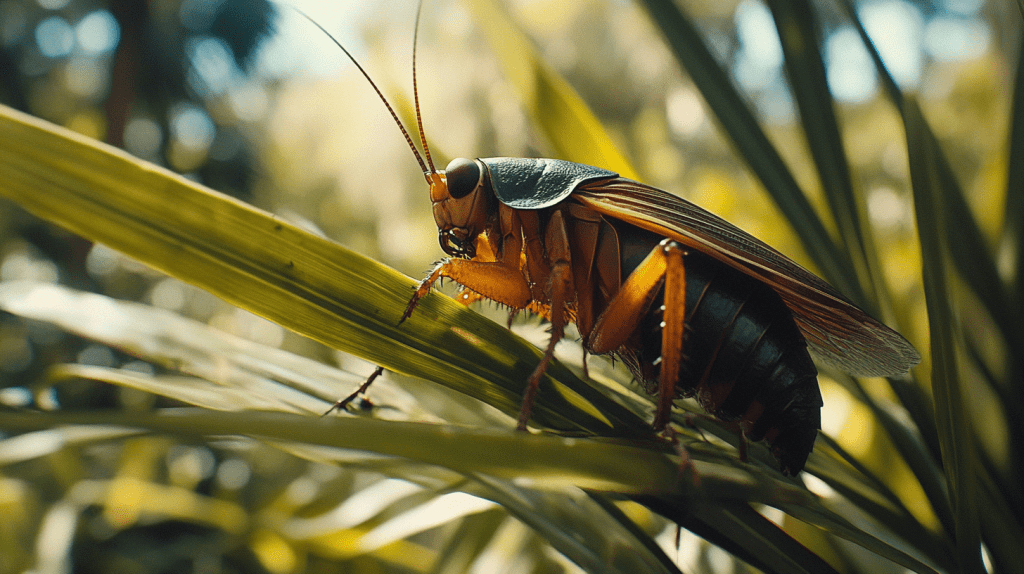
Dealing with cockroaches in Palmetto, FL requires a combination of effective strategies that target these resilient pests at every stage of their life cycle. From professional-grade solutions to natural repellents, here are the best methods to get rid of roaches and keep them out of your home.
Use Professional-Grade Baits
Professional baits are highly effective for long-term cockroach control. Consider using products like:
- Advion Cockroach Gel Bait: Apply small amounts in dark corners, under appliances, and areas where roaches are commonly seen.
- RAID Double Action Cockroach Bait: Place bait boxes in kitchen corners, cabinets, and pantries to tackle infestations.
- Bayer Cockroach Gel: Regularly apply in roach-prone areas like baseboards and under sinks, and replenish as needed for consistent results.
Natural Repellents
If you prefer a more eco-friendly approach, try these natural roach repellents:
- Peppermint essential oil: Mix with water (1:1 ratio) and spray in areas frequented by roaches. The strong scent repels them while being safe for your home.
- Tea tree oil: Combine with 1 part vinegar and 4 parts water, then spray in cabinets and entry points to deter roaches.
- Rosemary: Place sprigs of rosemary in cabinets or use rosemary oil spray to repel roaches naturally.
- Neem oil: Apply neem oil directly to areas where roaches hide or create a spray solution for larger spaces.
DIY Baits
Homemade baits are another effective method to eliminate roaches:
- Boric acid and sugar mixture: Mix equal parts and place small amounts around your kitchen and bathroom where roaches are likely to travel.
- Oatmeal and baking soda bait: This combination is toxic to roaches when ingested and can be placed in corners and along baseboards.
Seal Entry Points
Roaches can enter your home through tiny cracks and gaps, so it’s important to:
- Inspect your home for entry points, including around windows, doors, and plumbing.
- Seal these openings with caulk or weather stripping to prevent new roaches from entering.
Maintain Cleanliness
Cockroaches are attracted to food and moisture, so:
- Regularly clean kitchen areas, removing food debris, crumbs, and spills.
- Keep garbage in sealed containers and dispose of it frequently to reduce food sources.
Reduce Moisture
Roaches thrive in damp environments, so:
- Fix leaky pipes or faucets and dry out wet areas.
- Use dehumidifiers in damp places like basements to reduce moisture and make your home less inviting for roaches.
Professional Pest Control
For more severe infestations, hiring a professional pest control service in Palmetto, FL may be necessary. Professionals can offer targeted treatments and ongoing management to ensure your home remains roach-free.
Be Patient and Persistent
Successfully getting rid of roaches takes time and consistency:
- Continue treatments for several weeks, monitoring progress and adjusting your methods as needed.
- Combine multiple strategies for the best results, and always follow safety precautions when using any form of pesticide or bait.
Cockroach Control Methods in Palmetto, FL
1. Use Professional-Grade Baits
- Advion Cockroach Gel Bait: Apply small amounts in dark corners and areas frequented by roaches.
- RAID Double Action Cockroach Bait: Place bait boxes in kitchen corners and inside cabinets.
- Bayer Cockroach Gel: Apply in cockroach-prone areas and replenish regularly.
2. Natural Repellents
- Peppermint essential oil: Mix with water (1:1 ratio) and spray in roach-prone areas.
- Tea tree oil: Mix a few drops with 1 part vinegar and 4 parts water, then spray.
- Rosemary: Place sprigs in areas frequented by roaches or use rosemary oil spray.
- Neem oil: Create a spray solution or apply powdered form in roach-prone areas.
3. DIY Baits
- Boric acid and sugar mixture: Mix equal parts and place in small amounts where roaches are seen.
- Oatmeal and baking soda bait: Combine and place in roach-prone areas.
4. Seal Entry Points
Inspect your home for cracks, crevices, and gaps around doors and windows. Seal these openings to prevent new roaches from entering.
5. Maintain Cleanliness
Regularly clean kitchen areas, removing food debris and crumbs. Keep garbage in sealed containers and dispose of it frequently.
6. Reduce Moisture
Fix any leaky pipes or faucets. Use dehumidifiers in damp areas like basements.
7. Professional Pest Control
For severe infestations, consider hiring a professional pest control service. They can provide targeted treatments and ongoing management plans.
8. Be Patient and Persistent
Roach control often takes time. Continue treatments for several weeks and monitor the situation, adjusting your approach as needed.
Palmetto’s warm, humid climate is ideal for cockroaches, so ongoing prevention and management are key. Combine multiple methods for the best results, and always follow safety precautions when using pesticides or baits.
Roach infestations in Palmetto can be particularly challenging due to the warm, humid climate, but with a persistent and multi-faceted approach, you can reclaim your home and keep roaches at bay.
Getting Rid of Roaches With Professional Roach Control Products
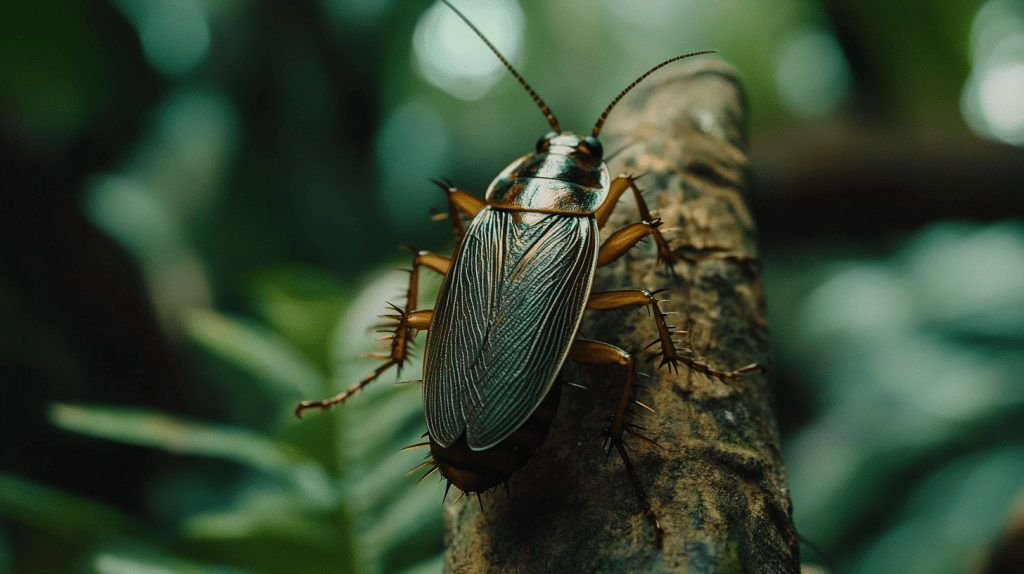
Tired of seeing German roaches skitter across your kitchen floor in Palmetto, FL? Let’s jump into the best professional products to help you reclaim your home.
Insect Growth Regulators (IGRs)
Insect Growth Regulators (IGRs) work wonders on German roaches. They don’t outright kill roaches but disrupt their life cycle. Imagine a roach trap that prevents babies from becoming adults. When used alongside baits or insecticide sprays, they pack a one-two punch. Products like Gentrol Point Source or Tekko Pro are popular choices. They ensure that even if a roach survives an initial spray, it won’t reproduce.

Effective Roach Control in Palmetto!
Tired of sharing your home with pests? Contact Palmetto Pest Control at (941) 294-3355 for prompt, professional service. Proudly serving Palmetto, FL, we provide effective pest solutions that keep your home safe and pest-free all year long.
Get StartedRoach Bait Stations
Roach bait stations act like covert spies in your war against roaches. They attract these pests, giving them poisoned food to bring back to their nest. The beauty of baits lies in their domino effect. When one roach consumes and shares the bait, it affects the entire colony. Advion Cockroach Gel Bait and Combat Max Roach Killing Bait are top recommendations for a do-it-yourself strategy. These baits are ideal for persistent infestations, especially in places where sprays might not reach, like behind appliances.
Professional Roach Sprays
Professional roach sprays are your frontline soldiers. They offer immediate knockdown power for visible roaches. Do you see one skittering in your bathroom at night? A targeted spray like Raid Ant & Roach Killer will quickly take care of it. Combine sprays with other methods to cover all bases. Sprays work best in areas with high activity, like baseboards, cabinets, and under sinks.
Cockroach Traps
Cockroach traps provide valuable insight into your infestation. Think of them as your intelligence team. Sticky traps capture the critters, showing where they’re most active. This helps focus your treatment efforts. Try glue traps like Black Flag Roach Motel, which are and easy to use. Place traps in dark corners, under the fridge, or beside the stove to monitor hot spots.
Local Resources
Palmetto, FL, is not just about sunshine and beaches; it’s also a battleground for roach control. Local pest control services can offer guidance tailored to your environment. Check out companies like Palmetto Pest Control. Their expertise ensures comprehensive treatment, especially if DIY methods aren’t enough.
Conclusion – How to Get Rid Of Roaches
Achieving a roach-free home is within your reach. By understanding the habits of different roach species and employing targeted strategies, you can effectively combat these pests. Regular inspections and maintaining a clean environment are crucial in preventing infestations.
Use appropriate treatment plans and seal entry points to keep roaches out. Whether you opt for DIY solutions or professional help, consistency is key. With the right approach, you can enjoy a pest-free home and peace of mind.
Frequently Asked Questions
How can I identify the type of roaches in my home?
To identify roaches, use flashlights and glue traps. German and Brown-Banded roaches are smaller and prefer dark, moist areas like kitchens and bathrooms. Larger roaches, such as American, Australian, and Smoky Brown roaches, usually live outdoors but may enter homes during extreme weather.
Where are cockroaches typically found in the home?
Smaller roaches like the German species are usually found in kitchens and bathrooms. Larger roaches, such as American and Smoky Brown roaches, generally live outside but can enter homes in extreme weather conditions.
Why is sanitation important in preventing roach infestations?
Roaches thrive in unclean environments. It’s crucial to clean up food spills immediately, store food securely, and fix any leaks to prevent attracting roaches to your home.
What are effective treatment options for getting rid of cockroaches?
Treatment options include using gels, baits, insect growth regulators (IGRs), professional-grade sprays, and natural remedies like boric acid and diatomaceous earth. Tailor your treatment plan based on the type of roach infestation.
How do German and American roaches pose health risks?
German and Brown-Banded roaches can carry bacteria like Salmonella and E. coli, leading to food poisoning and respiratory issues. American roaches can introduce bacteria and viruses from sewers, posing additional health risks.
What are specific treatment recommendations for German roaches?
For German roaches, use bait stations and IGRs to disrupt their life cycle. Additionally, professional-grade sprays and natural remedies like diatomaceous earth can be effective.
What are specific treatment recommendations for American roaches?
Use residual insecticides, granular baits, and sticky traps to monitor and eliminate American roaches. Sealing entry points and maintaining cleanliness are also crucial to prevent re-infestation.
When should I seek professional help for a roach infestation?
If DIY solutions are insufficient and the infestation persists, it’s advisable to seek professional help. Exterminators have the expertise and tools for comprehensive pest control.
How can I prevent future roach infestations?
Eliminate food sources, maintain cleanliness, and seal entry points to deter roaches. Regular monitoring, using sticky traps, and applying treatments around common entry points can help maintain a pest-free environment.
Are DIY pest control strategies effective against roaches?
Yes, many DIY pest control strategies are effective against roaches. These include bait stations, sprays, natural remedies, and monitoring traps. However, for severe infestations, professional help may be required.





